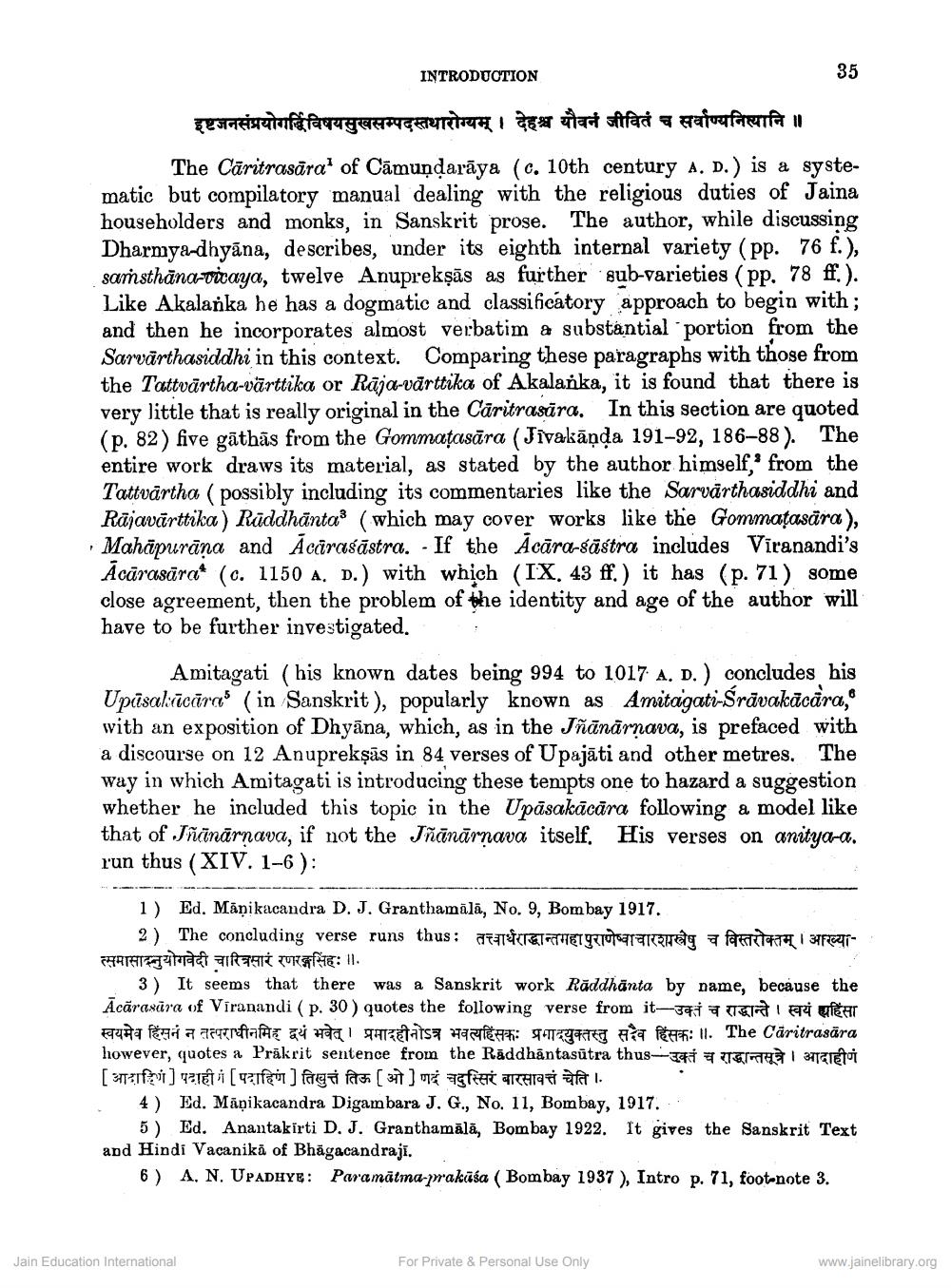________________
INTRODUCTION
35
इष्टजनसंप्रयोगर्द्धिविषयसुखसम्पदस्तथारोग्यम् । देहश्च यौवनं जीवितं च सर्वाण्यनित्यानि ॥
The Cäritrasāra' of Cāmundarāya (c. 10th century A. D.) is a systematic but compilatory manual dealing with the religious duties of Jaina householders and monks, in Sanskrit prose. The author, while discussing Dharmya-dhyāna, describes, under its eighth internal variety (pp. 76 f.), saṁsthāna-vicaya, twelve Anuprekşās as further sub-varieties (pp. 78 ff.). Like Akalanka he has a dogmatic and classificatory approach to begin with; and then he incorporates almost verbatim a substantial portion from the
crvärthasiddhi in this context. Comparing these paragraphs with those from the Tattvärtha-värttika or Rāja-vārttika of Akalanka, it is found that there is very little that is really original in the Caritrasüra. In this section are quoted (p. 82) five gāthās from the Gommațasāra (Jivakāņda 191-92, 186-88). The entire work draws its material, as stated by the author himself, from the Tattvartha (possibly including its commentaries like the Sarvärthasiddhi and Rājavärttika) Rāddhānta(which may cover works like the Gommatasära ), Mahäpurāna and Acärasāstra. - If the Acāra-sästra includes Viranandi's Ācārasāra (c. 1150 A, D.) with whịch (IX. 43 ff.) it has (p. 71) some close agreement, then the problem of the identity and age of the author will have to be further investigated :
Amitagati (his known dates being 994 to 1017 A. D.) concludes his Upāsakācāras (in Sanskrit), popularly known as Amitagati-Śrāvakācāra, with an exposition of Dhyāna, which, as in the Jñānārnava, is prefaced with a discourse on 12 Anuprekşās in 84 verses of Upajāti and other metres. The way in which Amitagati is introducing these tempts one to hazard a suggestion whether he included this topic in the Upāsakācāra following a model like that of Jñanārnava, if not the Jñānārnava itself. His verses on anitya-a. run thus (XIV. 1-6):
1) Ed. Māņikacandra D. J. Granthamālā, No. 9, Bombay 1917.
2) The concluding verse runs thus: ataTaT&IFTTHETETTocarek eg fart i 3Fcसमासादनुयोगवेदी चारित्रसारं रणरङ्गसिंहः ।।.
3) It seems that there was a Sanskrit work Rāddhānta by name, because the Ācārasära of Viranandi (p. 30 ) quotes the following verse from it-39116 i EAT ETYR AT a arftat a HETTI THEtatsa HIPH: SHITET AT RE: II. The Căritrasāra however, quotes a Prākrit sentence from the Rāddhantasūtra thus - Tari TTIETO [आदाहिगं] पदाही गं [पदाहिण ] तिखुत्तं तिऊ [ओ] णदं चदुस्सिरं बारसावत्तं चेति ।
4) Ed. Māņikacandra Digambara J. G., No. 11, Bombay, 1917.
5) Ed. Anantakirti D. J. Granthamālā, Bombay 1922. It gives the Sanskrit Text and Hindi Vacanik, of Bhāgacandraji.
6) A, N. UPADHYE: Paramātma-prakasa (Bombay 1937), Intro p. 71, foot-note 3.
Jain Education International
For Private & Personal Use Only
www.jainelibrary.org




